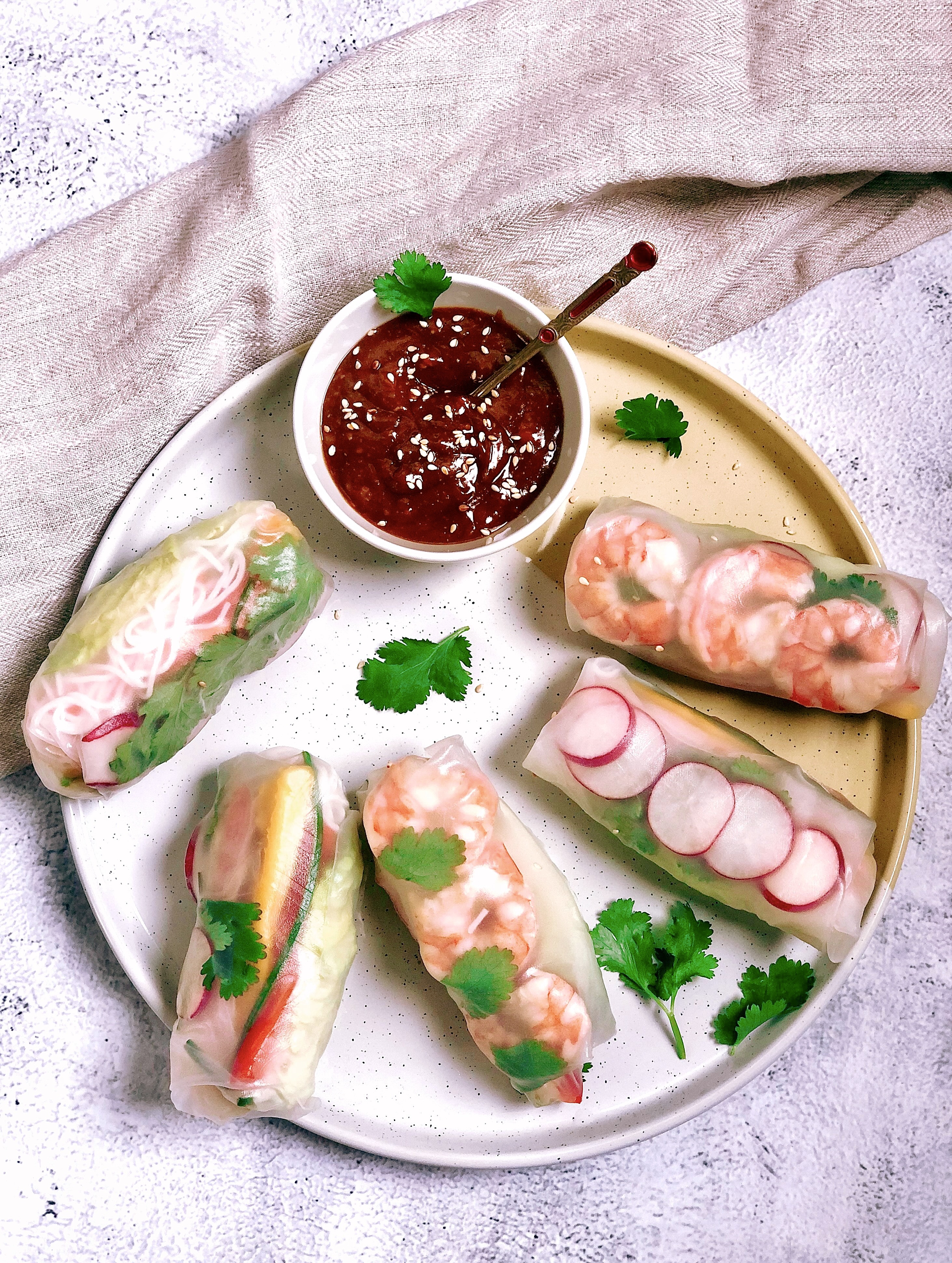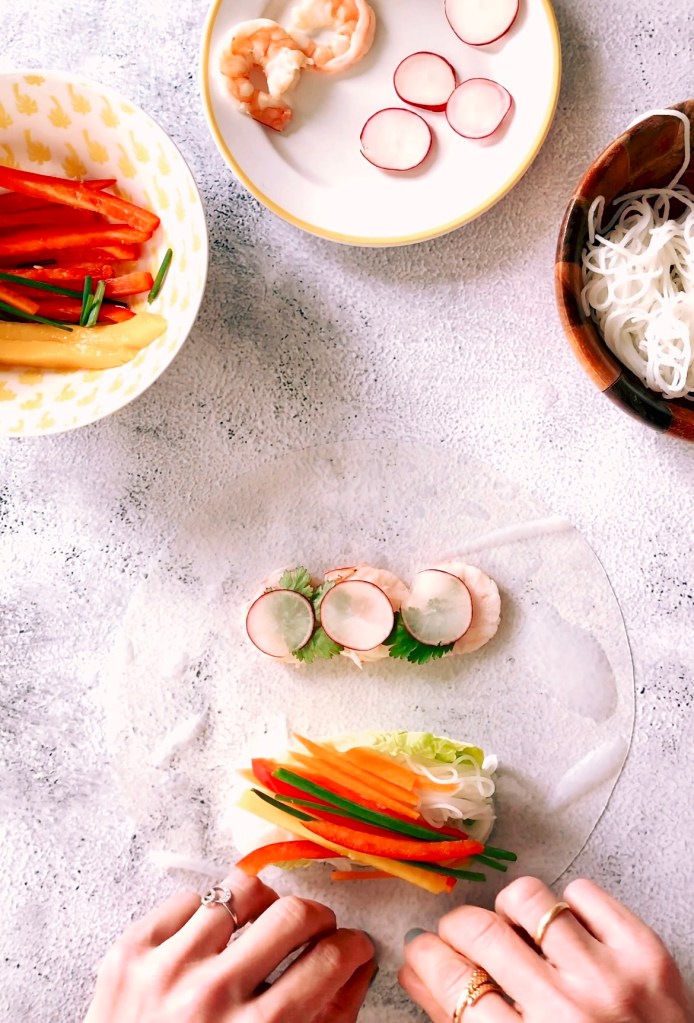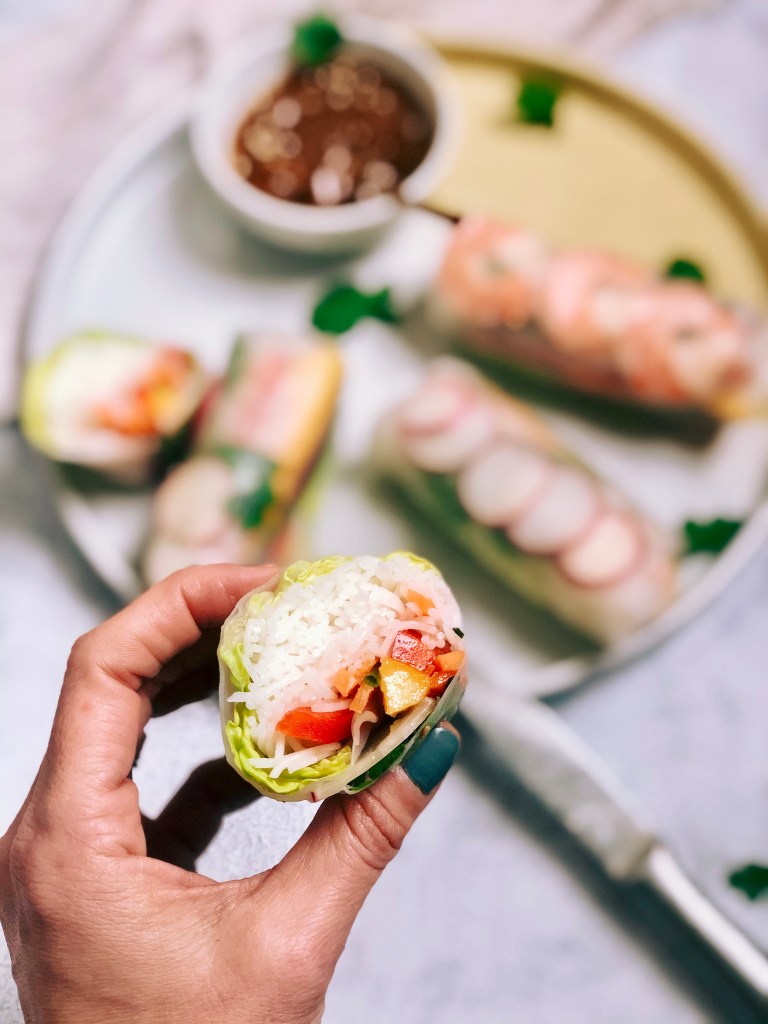
Scroll down for post in English
Hoy os traigo una receta fácil, bonita, saludable y rapidísima de preparar. No me diréis que no me supero cada vez. Si no habéis probado nunca Rollitos Vietnamitas espero que lo hagáis después de leer este post. Una vez que los probáis estoy segura de que no será vuestra última vez. Pero hablemos un poco de qué son los Rollitos Vietnamitas y de por qué son tan geniales.
Para empezar os contaré una curiosidad del nombre. Para nosotros en España estos rollitos se conocen como Rollitos Vietnamitas, hasta ahí todo bien porque en efecto son típicos de Vietnam. Pero sucede que en Vietnam hay muchos tipos de rollitos y aquí empieza el lío de nombres. De forma general, a los rollitos de verduras se les llama Rollitos de Primavera. Y me diréis ¿pero los rollitos de primavera que conocemos nosotros se hacen con otro tipo de masa y son fritos? Así es, y por eso para diferenciarlos, los fritos se llaman Rollitos de Primavera a secas y los que vamos a preparar hoy se llaman Rollitos de Primavera Frescos. ¿A que no era tan difícil? Pues sí, porque a los frescos a veces se les llama Rollitos de Verano para diferenciarlos de los Rollitos de Primavera (los fritos). Y por si todo lo anterior no fuera suficiente, si entra a jugar la nomenclatura anglosajona nos encontramos con que los Rollitos de Primavera (los fritos) para los estadounidenses son Egg Rolls, o sea, Rollitos de Huevo. Pero, ¿y qué ha pasado con la primavera? ¿Acaso los estadounidenses no tienen nada que se llame Rollitos de Primavera? Sí, los no fritos, los nuestros de hoy. Así que como sé que todo este lío te importa poco porque lo que quieres es hacerlos y comértelos ya, nosotros nos quedamos con que los que vamos a hacer hoy son Rollitos Vietnamitas y tan contentos. Sólo quiero que te quedes con que puede que los encuentres por el mundo como Rollitos de Primavera, Rollitos de Primavera Frescos o Rollitos de Verano.
El caso es que comoquiera que los llamemos, estos Rollitos Vietnamitas son una forma maravillosa de aportar a tu dieta una cantidad de verduras increíble. Es como hacerte una ensalada especial. En un formato diferente en el que no vas a necesitar cubiertos y el aliño se lo vas a poner en forma de salsa para mojar, en vez de vinagreta. A mí no hay nada que me guste más que pensar que en el fondo en todas las culturas gravitamos hacia los mismos tipos de comida pero las preparamos y las presentamos de formas diferentes.
Qué llevan los Rollitos Vietnamitas

Los dos únicos elementos imprescindibles de esta receta son las obleas de papel de arroz y los noodles de arroz. Ambos eran más difíciles de encontrar hace algunos años pero hoy en día tenemos fácil acceso en cualquier supermercado. No quiero que se me olvide mencionar que otro punto positivo para estos rollitos es que son gluten-free!
Una vez que tenemos las obleas y los noodles el resto de la receta es de las que me gustan a mí, completamente adaptable a lo que tengas, lo que te guste o lo que te apetezca. La idea es rellenar los rollitos con una mezcla de verduras crudas, hierbas y noodles, y si se desea, añadir algo de proteína. A la hora de elegir las verduras a mí me gusta jugar con las texturas. Al tener noodles en el relleno, ya tenemos un componente que es blandito por lo que a mí me gusta que las verduritas que pongo tengan cierta textura crujiente. Podéis jugar con sabores y hacer combinaciones en función de vuestros gustos. En mis rollitos por ejemplo siempre hay mango porque me encanta el contraste de sabor con las verduras y la salsa.
Enrollar los Rollitos

Enrollar los rollitos es mucho más fácil de lo que pueda parecer. En nuestra gastronomía no tenemos mucha tradición de enrollar burritos, pero si has enrollado un burrito, esto es lo mismo pero más fácil, porque el papel de arroz es súper flexible. No hay que preocuparse si no salen perfectos al principio, es cuestión de práctica. Pero os aseguro que se le coge la técnica en seguida y en cuanto la dominéis los vais a hacer muy rápido y vais a poder jugar con los ingredientes que queréis que se vean más o menos. A mí por ejemplo me gusta hacer dos secciones y colocar en una de ellas los elementos que van a quedar más visibles al enrollar pero esto no es necesario para nada.
Para mí la clave es tener todos los ingredientes cortados y preparados en modo línea de ensamblaje. La mise en place que dicen los chefs es fundamental en recetas en las que tienes que ir apilando una cosa encima de otra. En realidad la parte más larga, y me atrevería a decir que más compleja de la receta, es cortar las verduritas. Para que veáis lo difícil que es.
En cuanto a cómo hacer que las obleas de papel de arroz se vuelvan flexibles, es fácil. Sólo hay que sumergirlas en agua tibia. Dependiendo de la temperatura del agua y de las marcas tardan menos de un minuto o a veces hasta 3-4 minutos, pero tenéis que conseguir que queden como si fueran una membrana, como una telita fina y muy muy flexible pero que no se rompe. En el vídeo que os dejo al final de la receta podéis ver la consistencia a la que me refiero.
¿Se pueden preparar con antelación?
Pues en este caso os diré que no es lo ideal. Lo mejor es comerlos nada más hacerlos porque el papel de arroz una vez humedecido se vuelve correoso cuando empieza a resecarse. Si no tenéis más remedio que hacerlos con antelación yo los envolvería individualmente en papel de cocina húmedo y luego los metería en un tupper cerrado en la nevera. Pero en mi opinión y teniendo en cuenta que una vez que has enrollado dos o tres se hace muy rápido, lo mejor es tener toda la verdura cortada con antelación y enrollarlos en el momento que se vayan a comer. Os aseguro que no se tarda nada.
Salsa para acompañar
Hay distintos tipos de salsas con las que se pueden acompañar los rollitos, pero para mí ninguna como una salsa de cacahuete y chile. Esa mezcla me parece ideal y me gusta con todos los rellenos de rollito. Yo os voy a dejar aquí la receta de la salsa que hago yo para estos rollitos pero puedes comerlos con cualquier otra salsa que te guste hacer o comprar.
Yo creo que hemos cubierto los puntos más importantes así que vamos a pasar a la receta.
ROLLITOS VIETNAMITAS CON SALSA DE CACAHUETE
Ingredientes
Para los rollitos
- 10 obleas de papel de arroz
- 1/2 paquete de noodles finos de arroz cocidos siguiendo las instrucciones del paquete
- 10 hojas de cogollo de lechuga
- 1/2 pimiento rojo cortado en bastones finos
- 1/2 pimiento amarillo cortado en bastones
- 3 zanahorias cortadas en bastones
- 5-6 rabanitos cortados en rodajas finas
- 1 mango cortado en bastones
- Gambón cocido – OPCIONAL (se puede cortar por la mitad si es muy grueso)
- 10 ramitas de cebollino
- Hojas de hierbas aromáticas: cilantro, menta, hierbabuena, albahaca…
Para la salsa de cacahuete
- 3 cucharadas de crema de cacahuete
- 4 cucharadas de salsa de soja (usa tamari para que sea gluten free)
- 1 cucharada de vinagre de arroz
- 1 cucharada de aceite de sésamo
- 3 dientes de ajo picados
- 1 cucharada colmada de azúcar moreno
- Sriracha (opcional)
Pasos
- Prepara todos las verduras para tenerlas a mano y poder ir colocándolas fácilmente.
- Prepara los noodles siguiendo las instrucciones del paquete. Suele ser muy rápido y fácil. Normalmente sólo hay que sumergir los noodles en agua hirviendo, apagar el fuego y dejarlos reblandecerse durante unos 4 min. Escurrir y listo. Pero asegúrate de seguir las instrucciones del paquete por si fueran distintas.
- Prepara un recipiente grande en el que vaya a caber la oblea de arroz con agua templada. Sumerge la oblea hasta que se haya reblandecido. Puede tardar desde 30 segundos hasta 3-4 min. Dependerá de la temperatura del agua y de la marca de oblea así que vigila para que que no se reblandezca en exceso y se deshaga.
- Una vez blanda sácala con las dos manos con cuidado y dejando escurrir el exceso de agua, y colócala en una superficie plana y despejada. La encimera o una tabla grande por ejemplo.
- Apila los ingredientes del relleno en el tercio inferior de la oblea (el más cercano a ti). A mí me gusta empezar por la hoja de lechuga porque me proporciona una especie de recipiente natural sobre el que recoger el resto de ingredientes. A continuación pongo los noodles y a partir de ahí el resto. A veces me gusta hacer una segunda sección de relleno en la que pongo los elementos que van a quedar más visibles al enrollar pero esto no es necesario. Para empezar puedes practicar poniendo sólo un montoncito de relleno y enrollar.
- Comienza a enrollar desde abajo cubriendo el relleno con el papel de arroz. Dobla los laterales hacia el centro y termina de enrollar. Se ve más claro en el vídeo que te dejo aquí abajo.
- Haz la salsa mezclando todos los ingredientes hasta que tenga una textura cremosa.
- Sirve acompañados de la salsa para mojar y a disfrutar.
Si te ha gustado esta receta me puedes dejar un like
SPRING ROLLS WITH PEANUT SAUCE

Spring rolls, summer rolls, Vietnamese spring rolls. Whatever you call them, these veggie packed bundles make the perfect system for packing an insane amount of veggies into your diet. Once you get the hang of rolling up the rice paper, homemade spring rolls are so easy to make. What I love about this recipe is that not only is it healthy and flavorful but it’s also adaptable and extremely forgiving. You can use ingredients that you like and have on hand. I’m sharing what I typically put in them, but the options are endless, including bean sprouts, chicken, lettuce, bell peppers. And I absolutely love the dipping sauce: a simple peanut sweet chili sauce that puts them over the top.
What do you need to make Spring Rolls?
There is a couple of ingredients that you absolutely need in order to make this recipe. Those are Rice Paper Wrappers and Rice Vermicelli Noodles. Rice Paper Wrappers used to be hard to come by, but now they’re sold at most local grocery stores. And, rice paper wrappers are always gluten-free! Regarding the Rice Vermicelli, those are very thin rice noodles. Various manufacturers will call them thin rice noodles, rice sticks, or maifun. One important thing to note is that the cooking time of the noodles varies across brands. Use my recipe below as a guide, but double check the manufacturer’s suggested cooking time.
Once you have those two ingredients you are free to experiment with whatever you like to add to your rolls. My favorite filling is either a vegetarian mix of raw veggies, noodles and herbs, or maybe incorporate some protein like I did here adding shrimp to some of my rolls. I like to play around with textures when filling my rolls. Since the noodles make for a soft filling, I tend to add veggies that have a bit of a crunch. In terms of flavor you can also get creative and make tasty combinations. I absolutely love adding mango to my spring rolls. I love the sweet and juicy contrast.
How to assemble spring rolls?
These fresh spring rolls come together very very quickly so it’s a good idea to have all your ingredients assembled and prepped including the chopped veggies, noodles, herbs, and rice paper wrappers. Chop all of your vegetables into long, thin sticks.
Dip wrappers in water. Fill a large shallow dish or pie plate with an inch or so of lukewarm water. Remove one rice paper wrapper from the package at a time and place it in the water to soak for about 10 to 15 seconds or until soft and pliable. Depending on the temperature of your water or the brand of rice paper it may take longer. I have had to soak mine up to 3 minutes sometimes. Once soft, remove and place on a flat surface like your countertop or a large cutting board.
Now you just have to add the filling. I like to lay a piece of butter lettuce over the lower edge of the rice paperT. This will act as a natural container to the rest of the filling ingredientes. Then, top the lettuce with noodles, vegetables, herbs. Now you are ready to roll. Grab the lower edge of the rice paper with your thumbs and pointer fingers, lift, and roll up the spring roll. Use your other fingers to hold the filling together. Continue rolling the spring roll until the filling is covered. Then, fold the left and right sides of the spring roll toward the center. Finally, roll the spring roll all the way to the end.
It takes practice but as you get the hang of it you may want to start experimenting with other ways to present your ingredients. I like to pile my ingredients in two different sections of the paper roll because that way I can have some of the filling show more once the roll is all rolled up. I like to do that especially when I am using shrimp. By leaving a gap between the shrimp and vegetables, the shrimp will look more vibrant in the final roll because they will be covered by only one layer of rice paper.
Can I make Spring Rolls ahead of time?
Although you can prepare the filling and sauces up to 2 days ahead, I highly recommend that you consume spring rolls within several hours of making them. If you refrigerate spring rolls overnight, the rice paper hardens, and gets rubbery. What I would do if I absolutely needed to make the spring rolls ahead of time is wrap them individually in damp paper towels and store in an airtight container in the fridge, but again, I wouldn’t recommend doing this.
Let’s make them!
SPRING ROLLS WITH PEANUT SAUCE

Ingredients
For the rolls
- 10 rice paper wrappers
- 1/2 package rice vermicelli noodles
- 10 small romaine lettuce leaves or lettuces pieces if you only can find large romaine
- 1/2 red bell pepper cut into thin sticks
- 1/2 yellow bell pepper cut into thin sticks
- 3 carrots cut into thin sticks
- 5-6 radishes cut into thin slices
- 1 mango, peeled and cut into sticks
- Cooked shrimp – OPTIONAL
- Scallions
- Aromatics such as cilantro, mint, basil…
For the Peanut Sauce
- 3 Tbsps creamy peanut butter
- 4 Tbsps soy sauce (you can substitute tamari or coconut aminos)
- 1 Tbsp rice vinegar
- 1 Tbsp sesame oil
- 3 garlic cloves, minced
- 1 heaping Tbsp brown sugar
- Sriracha (optional)
Method
- Set up your Spring Roll station by getting all your veggies cut and ready to use.
- Cook noodles following instructions in the package as they may vary across brands.
- Dip a sheet of rice paper in the lukewarm water to moisten the entire surface. This could take from a few seconds up to 2 min depending on how warm is your water and the rice paper brand. Allow it to drain excess water and transfer to your a flar working surface.
- Place a piece of butter lettuce close to the bottom edge of the rice paper. Arrange a small pinch each of rice noodles, carrots, bell pepper… You can start rolling your rolls now or you can arrange another row of ingredients for them to show more once the roll is done.
- Grab the lower edge of the rice paper and lettuce and start rolling up the spring roll. Once you have covered the filling, fold in the left and right sides. Finish rolling up the spring roll all the way to the end. You can take a look at the video above to get a better idea of the process.
- Combine all peanut sauce ingredients in a small bowl and whisk to combine.
- Serve roll along with the dipping sauce and enjoy.
